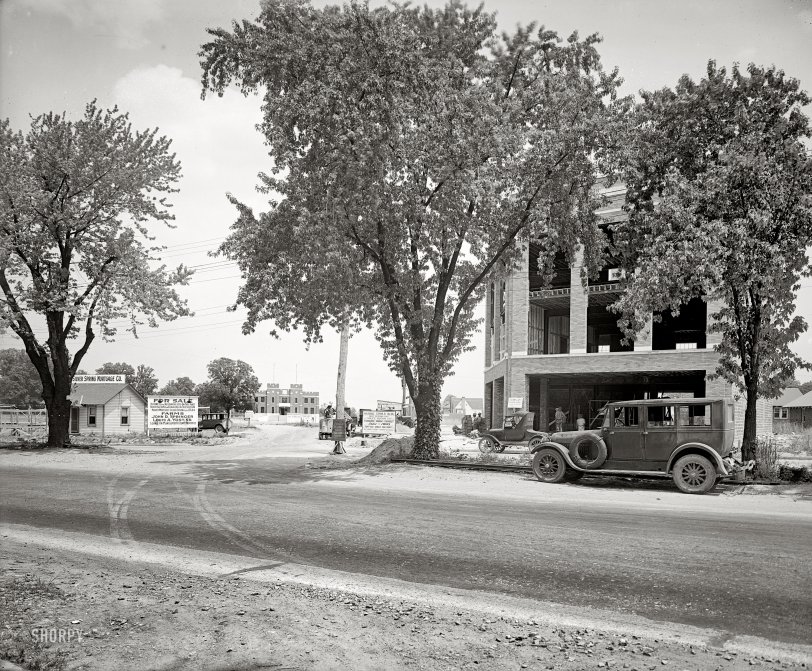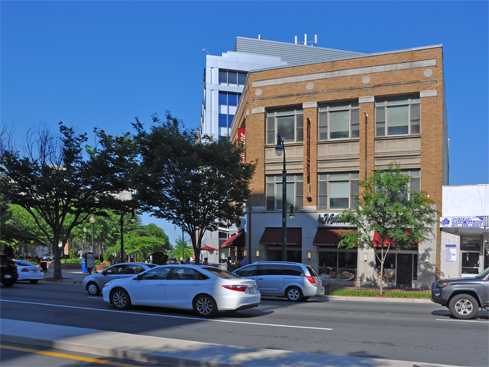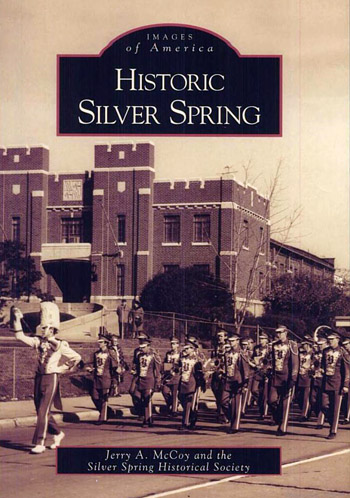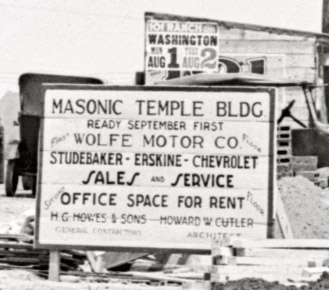


Framed or unframed, desk size to sofa size, printed by us in Arizona and Alabama since 2007. Explore now.
Shorpy is funded by you. Patreon contributors get an ad-free experience.
Learn more.

- Details, Details
- What's that building to the left of the tower?
- Coal Barges
- Bromo-Seltzer
- Inner harbor
- The Basin
- What a headache!
- Giant stepladder?
- Baldwin 62303
- Baldwin VO-1000
- Cold
- No expense spared
- Tough Guys
- Lost in Toyland
- And without gloves
- If I were a blindfolded time traveler
- Smoke Consumer Also Cooks
- Oh that stove!
- Possibly still there?
- What?!?
- $100 Reward
- Freeze Frame
- Texas Flyer wanted
- Just a Year Too Soon
- WWII -- Replacing men with women at the railroad crossing.
- Yes, Icing
- You kids drive me nuts!
- NOT An Easy Job
- I wonder
- Just add window boxes
Print Emporium
Silver Spring: 1927

Silver Spring, Maryland, circa 1927. The second of three National Photo glass negatives marked "Jordan & Co." Among the new construction shown here is a National Guard armory. National Photo Company Collection. View full size.
+89
Below is the same view from June of 2016.

Silver Spring Masonic Temple, 1928ish
Fine and Mellowed
The still existing building has a nice rhythm to it and has been able to survive quite nicely. Here's to another 82 plus years of service!
Concrete and Hudsons
This and the previous photo show concrete borders on the roadway, presumably added to widen early pavement to newer traffic standards. Some of the earliest remnants of California state highways show similar treatment. The 1924 Hudson shows the heavy construction that allowed John Steinbeck's Joad family to convert a 1926 Hudson Super Six into a makeshift truck to haul the family to California.
Coming Soon, Going Soon
Erskine was a secondary, lower-priced (but not low enough) brand sold by Studebaker from 1927 to 1930, named for the company's president, Albert R. Erskine. Initially it was assembled in its own factory in Detroit using a Continental engine, parts from Studebaker's inventory, and its own body tooling. "The Little Aristocrat," as the line of small cars was marketed, had a supposed European flair to its design. By its final year, the Erskine was a rebadged version of Studebaker's lowest-priced offerings.
In 1932-33, Studebaker marketed another low-priced line of small cars, Rockne, named after the Notre Dame football coach. Knute Rockne died in a plane crash shortly before the car's announcement; however, he had given the idea approval and had been a promotional spokesman for South Bend-based Studebaker for three years before his death.
Meanwhile, Studebaker acquired Pierce-Arrow in 1928 to address the other end of the buying spectrum, but sold it in 1934 after Studebaker's 1933 petition for receivership. Personally bankrupt as well as despondent, Albert Erskine shot himself on July 1, 1933.
Silver Spring Hall
Washington Post, Jun 19, 1927Silver Spring Hall Corner Stone Laid
Ceremony at $52,000 Masonic Building
Conducted by Lodge No. 215.Impressive exercises marked the laying of the corner stone yesterday afternoon of the handsome Masonic Hall Building that is being erected at Silver spring by the silver Spring Masonic Temple and Library Association.
...
The building is being built at the corner of Montgomery and Georgia avenues and when completed will represent an outlay of $52,000. It will be three stories in height and of brick construction with white stone trimmings. The first floor will be for business purposes; the second floor will be business offices and a modern kitchen, and the third floor will contain a large hall and other rooms for lodge purposes. It is understood the building will be ready for occupancy by not later then September 1.
The large building in the background is the Silver Spring Armory located at 925 Wayne Ave.
Silver Spring Armory
The brick fortress-style building visible just down Montgomery (now Wayne) Avenue is the newly-constructed (second) Silver Spring Armory. Constructed about 1927 and demolished in the late 1990s over the objections of preservationists, a later photo of it adorns the cover of "Historic Silver Spring."

US 29 and Wayne
According to "Historic Silver Spring," this photo was taken looking east on Montgomery (now Wayne) Avenue from Georgia Avenue (US 29). That should put it on Route 29 across from the Chicken Dinner.
Mix it up
That concrete mixer in the background is likely a Jaeger. I have a 3½-horse engine that came out of one. Jaeger got its engines from the Hercules of Evansville, Indiana.
The big old car
is a 1924 Hudson seven-passenger sedan. A very big car for the year, it cost over $2,000 when the Model T in the background was under $400.
Coming Soon
Plenty going on here. Now being built: a Masonic Temple and a sales and service area for Wolfe Motors with their valuable franchises (although Erskine doesn't mean much to me). Also farms and homes for sale and looks like there's mortgage money available from the Silver Spring people. The boom times would last a few more years and then reality will set in. Sound familiar?
History Mystery SOLVED!
Thank you for posting this image in far greater resolution than it had been previously available. In doing so you provided definitive proof that the 1927 Silver Spring Masonic Temple, on the southeast corner of Georgia and Wayne avenues, was designed by prominent local architect Howard Wright Cutler (1883-1948). Mr. Cutler designed structures throughout metropolitan Washington and lived in Silver Spring.
This architect deserves far greater visibility and the Silver Spring Historical Society is working on this endeavor. If anyone has information on Cutler, please contact me at sshistory@yahoo.com.
Thank you.
Jerry A. McCoy
President
SSHS

Still There
The office building to the right is still there. Also visible just to the right of the parked car are rails from the Washington, Woodside, and Forest Glen Railway, an interurban trolley line that connected Washington D.C. (via Georgia Avenue) with the National Park Seminary just north of Silver Spring. Organized in 1895, this portion of the the trolley operation was defunct by 1925 and its rails were evidently destined for scrap by the time of this photo, thanks to the advent of asphalt-paved roads and increasingly reliable automobiles.

























On Shorpy:
Today’s Top 5